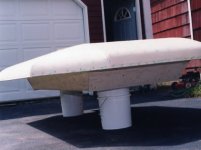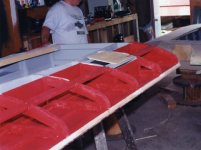Thanks for the responses gents.....I am currently building some layout / marsh boats of my own "eyeball it" design, refined along the way, of course......no plans......no help.....just me and Peso fetching up some birds and building a boat = the Hammertime way !!
I am bending 5.2mm lauan over a frame on it, but I am wanting to experiment with other methods / plywood thicknesses / laminates & wacky wood / etc.....your reponses have been very helpful indeed. I will be making some serious mods on the next one - this one is kind of plain. But then again, I am not as well outfitted as a true woodworker should be.......all I have is a drill, a circular saw, and a rotozip!! whoa!
This week my timeline has been slowed down, as I've been busy with some tedious fillets - wow that's time consuming! I am using cabosil on this one....I think I will try wood flour next time. The cabosil is too light - it has a mind of it's own and flies out of the tub. It also takes too much trouble to get enough mixed up....eats up the resin.
If anyone is down my way, hit me up and come by....we'll look at the boat and go work some dogs!
Best regards,
Bryant




